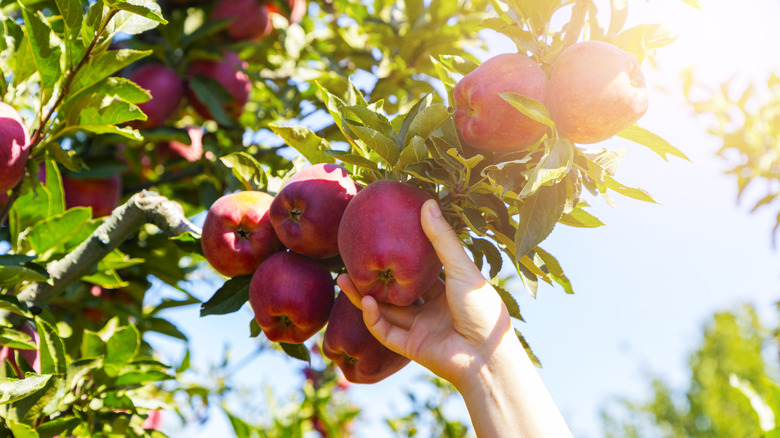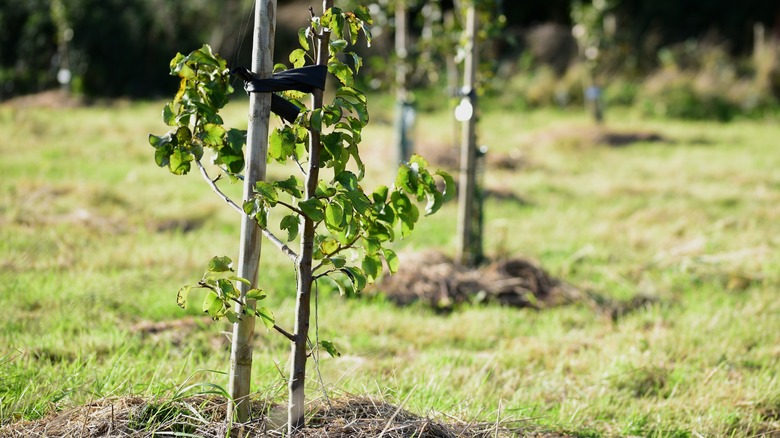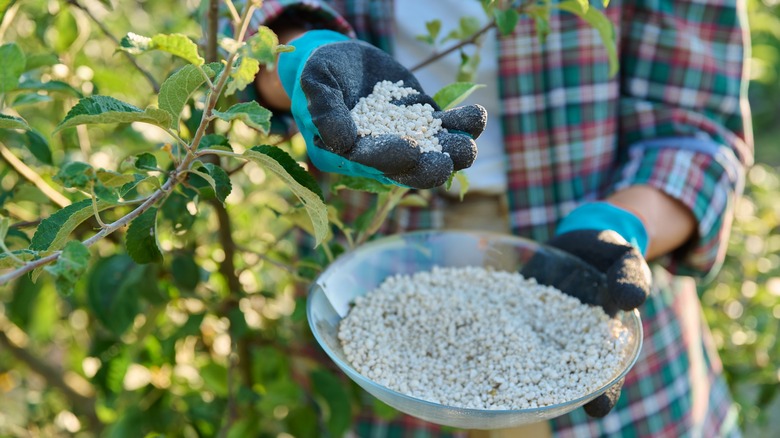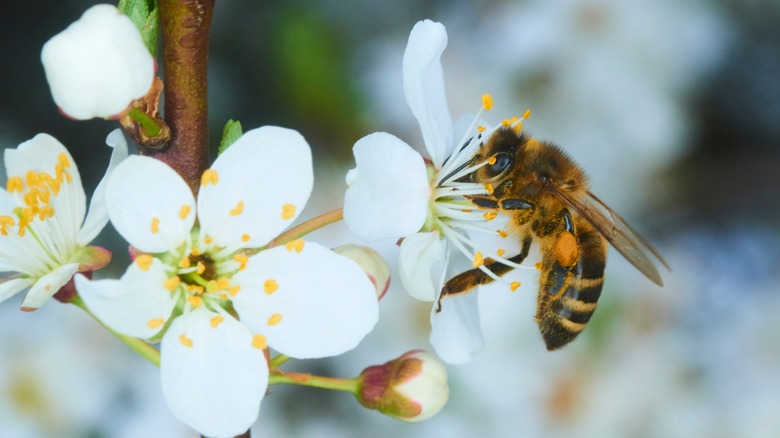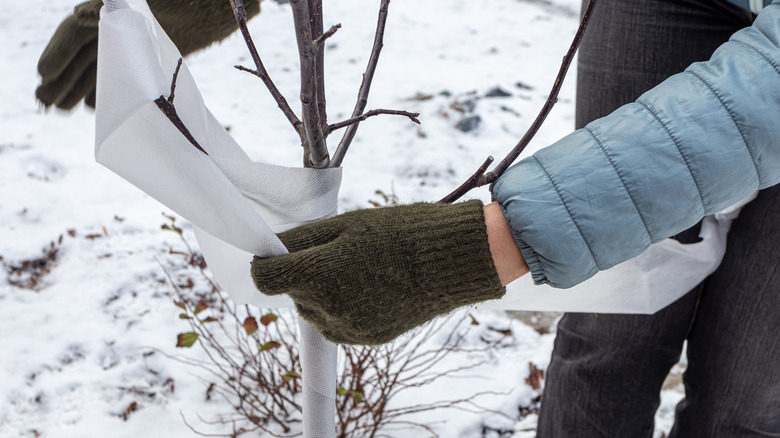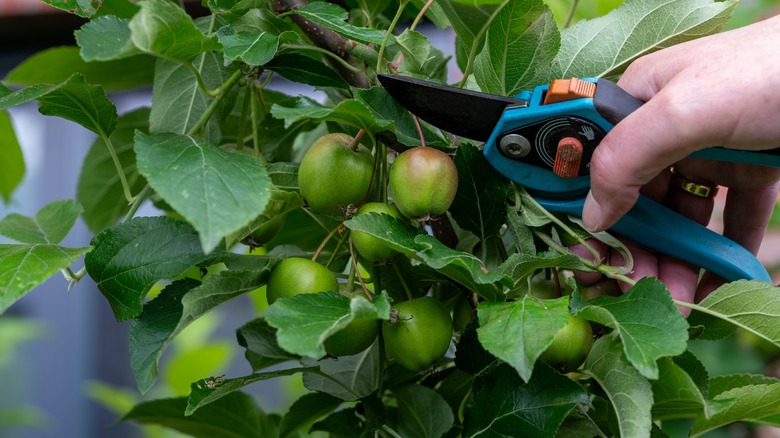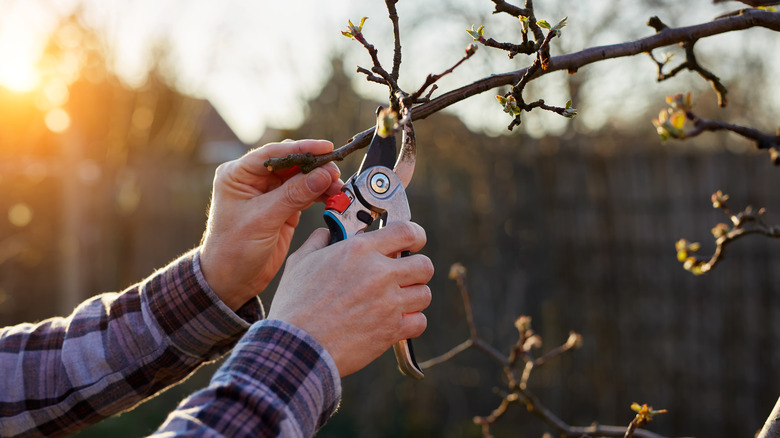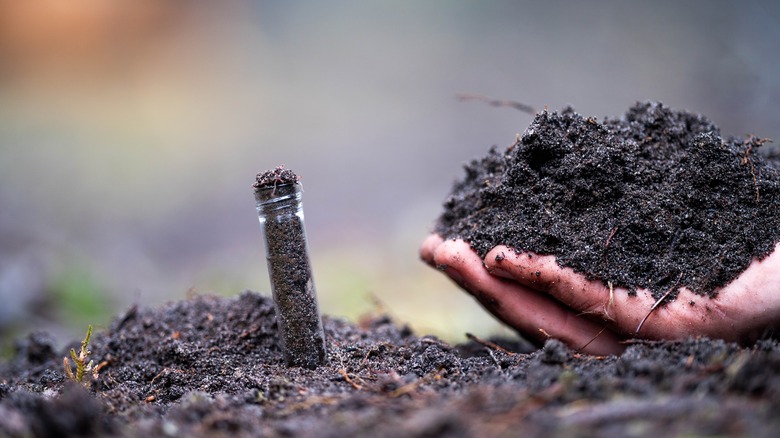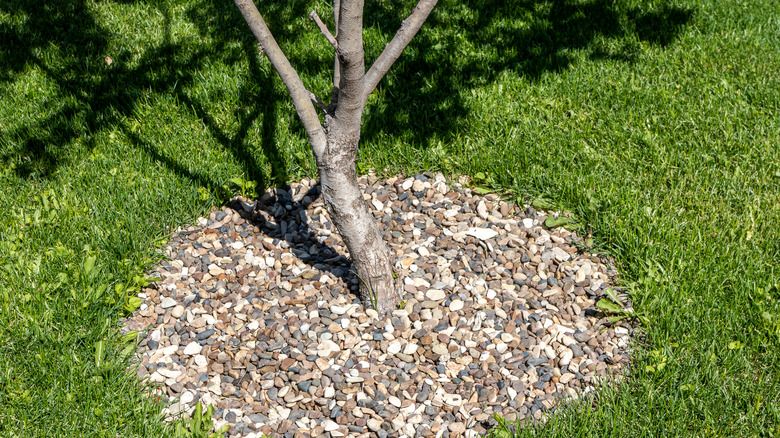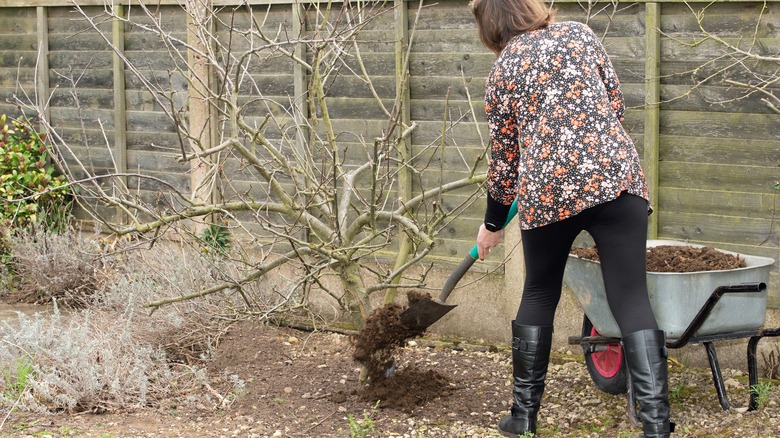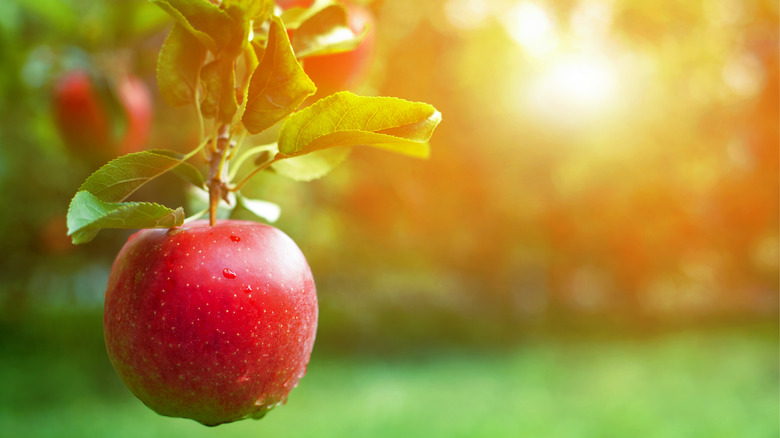Tips & Tricks You Need To Help The Apple Trees In Your Yard Thrive
We may receive a commission on purchases made from links.
Apple trees are an enormously popular fruit tree to grow. This is no surprise, given that they can supply a family with an abundance of delicious fruit with routine maintenance and care. They are also known to be able to survive in a range of conditions, growing in USDA climate zones 4 through 9. Plus, they will tolerate various soil types and can even grow in shade. However, if you want to get the most out of the apple trees in your yard and really see them thrive, then you'll need to pay close attention to their care requirements and ensure you are meeting them.
There are various tips and tricks you can employ to take your apple tree from surviving to thriving. The great news is that these tips are easy enough for the average gardening enthusiast to get involved in. From protecting the trunk from pesky wildlife to using an appropriate type of fertilizer, there are a range of simple solutions you can use to help your apple tree produce larger and more flavorful fruits.
Provide appropriate growing room so the apple tree can reach its potential
All types of apple trees, even the dwarf varieties, need plenty of space to grow. This includes ensuring they have adequate room above ground for their branches to spread out. It's also essential to give them space at the root level so they aren't competing with other species for nutrients and moisture. Experts recommend against growing apple trees amongst lawns because the roots of the grass will compete with the tree roots. This could prevent the tree from getting the moisture it needs to thrive and reduce its growth.
So, an area of the ground should be cleared to prevent this issue. If your tree is growing on your lawn, or you'd like to plant one among your grass, you should dig up a shallow circle with a 3-foot radius around the base. This will give the tree better access to moisture and nutrients to help it thrive. The area can be mulched to prevent grasses or weeds from appearing and to retain moisture. You should also allow enough space around the canopy of the tree for it to spread out and gain strong limbs. So, be cautious of planting other trees and shrubs too close to it.
Feed apple trees with an appropriate fertilizer for optimum growth
When an apple tree is grown in an ideal environment, it can do well without much fertilization. However, if your soil is not rich in nutrients, or you want to give your tree a helping hand to thrive, it should be fed on an annual basis. The type of fertilizer you should use, and the amount you should apply, will depend on the variety and age of the tree.
Apple trees need plenty of potassium, which is essential for the proper development and growth of the tree and to encourage a good yield of fruit. Organic gardeners can use blood, fish, and bone meal fertilizer or try a potassium-specific product such as The Grow Co.'s Muriate of Potash. The condition of your soil will also help to determine what type of fertilizer your trees will benefit from. Austin Little, a horticulture educator at the University of Illinois Extension, says, "The best way to find out if you need fertilizer is to get a soil test." It can be useful to have your soil tested every few years to best understand how to feed your apple tree. Use your chosen fertilizer every year, applying it to apple trees in the ground in early spring and those in containers in mid to late spring.
Plant two varieties to ensure cross-pollination
Apple trees need to be cross-pollinated to create fruit. This means while they are in bloom, they need to be visited by insects such as bees that have also visited other varieties of apple trees. If there are a few in neighboring yards, then your lone tree may be able to successfully produce fruit. But, to be on the safe side, it's a good idea to plant two different varieties within 100 feet of each other to encourage cross-pollination.
A crabapple is a common choice that can work as a variety for the purpose of cross-pollination. When selecting two varieties it's crucial to pay attention to their flowering time. For a successful cross-pollination, the flowers of the tree will need to bloom at the same time, but not all varieties flower simultaneously. For example, Red Delicious is a mid-season bloomer, flowering in late April to May. So, it could be cross-pollinated with other mid-season flowering varieties such as Golden Delicious or Gala.
Protect tree trunks from wildlife and weather
In winter, when food for wildlife is scarce, small mammals like rabbits and voles will chew on the bark causing significant injury, making the tree more susceptible to disease. Deer have also been known to rub their antlers up against trunks, which can also damage the bark. The best way to keep your trees safe from animal damage in the winter is to install a tree guard, which is typically made from plastic. Tree guards prevent these pests from gaining access to the trunk while also deflecting sunlight. This is vital in protecting the tree from sunscald, which can happen when the trunk heats up and then freezes again in a short space of time, causing internal damage within the tissue of the plant.
Ideally, tree guards should be fitted around apple trees when they are planted because young trees are at the most risk from damage and injury. However, there are options that you can add at any time. Adjustable ones like this Pack of Tree Guards can be purchased from Amazon or at your local nursery.
Encourage better fruiting by thinning out crops every summer
An abundant harvest of apples sounds great, but if your tree is producing too much fruit it can actually be a problem. Your apple tree only has so much energy to go around, so if it has to split this energy between an excessive amount of fruit, you can expect the developing apples to struggle. A heavy crop can also result in biennial bearing, which means few or no flowers the following year, and subsequently, a lack of fruit. To help the apple tree thrive, thinning out fruits each summer is essential. This will ensure it only develops as many apples as it can handle, resulting in fruit that has a better size, shape, and color.
The best time to prune your apple tree to thin out the fruit will depend on the variety you're growing because some are in bloom at different times of the year. In general, you should be inspecting your apple trees in June or July to see if the fruits are ready to be thinned. You will know it is time when the apples are around the size of a marble. Use garden shears to remove fruits, leaving just one or two apples on each cluster. A distance of 4 to 6 inches should be created between apples growing on the same branch. This practice, although it may seem counterintuitive, will result in a healthier harvest every year.
Prune annually to prioritize tree strength and fruit production
Annual pruning promotes better fruit production, especially when the tree is young. This allows for better airflow between branches, which can help prevent the development of disease. Proper pruning will also encourage the growth of new spurs where apples are produced, resulting in an improved harvest. Additionally, annual pruning will develop a good structure for overall tree health. Horticulturist Nicole Sanchez says via Oregon State University, "Don't expect a new young tree to start bearing well until probably its fourth or fifth year. In the long run, the tree will do better to put its energy into root and limb growth rather than fruit for those first few years. So, concentrate your pruning to produce a strong tree during that period."
Correct pruning methods are crucial if you want to successfully grow and care for an apple tree. The best time to prune is just before spring arrives when apple trees are still dormant, but the freezing weather has passed. When the tree is young, aim to remove branches that veer off from the central branch at a severe angle, as these tend to weaken the tree. Also, prune branches that cross with other branches, as this inhibits airflow and can encourage disease. For mature apple trees, aim to remove old limbs aged three to five years that are slowing down in terms of fruit production. This will spur the growth of new limbs that will produce more apples.
Test your soil and make amendments if required
For apple trees to flourish, you need to have a clear understanding of soil health and how this relates to its needs. While they might be growing fine without soil testing and amendments, they could perform even better if you customize your soil to meet their requirements. It's a good idea to have your soil tested before you plant your tree because this will allow you to make any recommended changes in advance. And in some cases, the results might indicate that your soil isn't appropriate for growing an apple tree at all. Many universities offer a soil testing service free of charge, so take advantage of this service to better understand how to prepare or amend it.
Apple trees will thrive in soils that have a sandy loam or sandy clay loam texture. They also need good drainage for roots to remain healthy. When drainage is poor, you can expect stunted growth and poor fruit production. Add sand to soil that isn't draining well, and pay attention to the pH of your growing substrate. The ideal pH for the soil where apple trees are growing is 6.5, which is slightly acidic. To make your soil more acidic for a thriving apple tree, purchase a fertilizer like Greenway Biotech Organic Sulfur Powder, and apply the recommended quantities to your soil.
Weed and mulch at the base of the tree to keep pests at bay
Apple trees are susceptible to a range of pests, including borers that primarily feed on the bark and branches of young or weakened trees. If left unchecked, a pest infestation on the trunk can lead to the death of the tree. One way to inhibit pests from taking up residence on your apple tree is to weed and mulch around the base of the trunk. Maintaining weed-free soil beneath the canopy of the apple tree will minimize the prevalence of small vertebrates and boring insects. Mulching over this area will help to prevent weeds from returning, and it will also conserve moisture and nutrients in the soil, which can be especially useful for growers in dry climates because apple trees don't fare well in drought.
Before mulching beneath the apple tree, you'll need to make sure all traces of weeds have been removed. Look into the least harmful ways to kill weeds as this will prevent potentially damaging chemicals from coming into contact with the tree. Once the weeds are gone, lay down a sheet of landscaping material and secure this in place. These types of fabrics, like Iropro's Woven Weed Control, work as a physical barrier to prevent weeds from coming back while allowing air and moisture to pass through to the soil. Mulch on top of the fabric with your chosen material, such as gravel or wood chippings. The mulch should be around 2 to 3 inches deep, covering an area about 12 inches wide around the trunk of the tree.
Use top-quality compost to encourage good soil aeration
Good levels of aeration in the soil will help most plants to thrive, but apple trees in particular will benefit from this. They cannot survive in heavy, compacted soils where there is a lack of air, because this will prevent their roots from being able to draw in moisture and nutrients. Since apple trees are not drought-tolerant, well-aerated soil with adequate oxygen is required to allow their roots to take in what they need to survive. You can aerate your soil by using high-quality compost, which will relieve compaction and improve aeration around the roots.
Ideally, you should use top-quality compost when planting your apple tree to give it the best start in your yard. Work some compost into the hole where the apple tree root ball will be planted, and add backfill around the roots with a mixture of compost, sand, and topsoil. You can also work compost into the soil after the apple tree is established. How much compost you should add to your soil will depend on its current condition. When planting a new tree, aim to use soil that is made up of 10% compost. When using compost as a topsoil for established ones, apply up to half an inch from the trunk out towards the edge of your bed.
Allow access to plenty of sun to minimize disease risk and improve fruit production
Apple trees can be grown in shady conditions, but this is not recommended for best growth. While these fruit trees can survive with a lack of direct sunlight, they won't thrive. Apple trees grown in shade can take several more years to produce fruit compared with those grown in full sun. If apple trees are grown in the shade this also leaves them more vulnerable to disease.
Access to sunlight is one of the things to consider before planting a fruit tree in your backyard. Apple trees require full sun for optimum growth, so they should be situated in a spot where nearby buildings or structures won't shade them. Consider any nearby trees or large shrubs, and whether or not they might put the apple tree in shade when they are fully grown. Look for areas that are exposed to early sun rising from the east. This will help to dry morning dew from the leaves, creating a dry environment that won't harbor fungal diseases.
